Global Trends and Current Advances in Slow/Controlled-Release Fertilizers: A Bibliometric Analysis from 1990 to 2023
Abstract
:1. Introduction
- Provide a concise overview of the predominant types of SRFs/CRFs in contemporary use while detailing the challenges associated with these specific categories of fertilizers. Additionally, it highlights potential future developments in preparation techniques and emerging materials in the field.
- Generate and visualize the publication trends regarding the literature associated with SRFs/CRFs.
- Examine the collaborative networks among leading groups, as characterized by their geographic distribution, prominent collaborations, and highly productive authors in the field.
- Examine the research focus and evolution of slow-release and controlled-release fertilizers (SRFs/CRFs) from 1990 to 2023.
- Identify current research limitations and explore potential future directions in the field of SRFs/CRFs.
2. Methodology
2.1. Database and Search Strategy
2.2. Data Analysis
3. Results
3.1. Publication Trends
3.2. Subject Categories
3.3. Contribution of Countries and Institutions
3.4. Contribution of Journals
3.5. Contribution of Authors
3.6. Highly Impactful and Highly Cited Publications
3.7. Keyword Analysis
3.7.1. High-Frequency Keywords
3.7.2. Keywords Co-Occurrence Analysis
3.7.3. Keyword Burst Analysis
4. Challenges and Future Research Prospects
4.1. Emerging Preparation Techniques and Materials for SRFs/CRFs
4.2. Mechanism and Model Simulation of Nutrient Release from SRFs/CRFs
5. Conclusions and Limitations
Author Contributions
Funding
Data Availability Statement
Conflicts of Interest
References
- El-Naggar, A.; Lee, S.S.; Rinklebe, J.; Farooq, M.; Song, H.; Sarmah, A.K.; Zimmerman, A.R.; Ahmad, M.; Shaheen, S.M.; Ok, Y.S. Biochar application to low fertility soils: A review of current status, and future prospects. Geoderma 2019, 337, 536–554. [Google Scholar] [CrossRef]
- Sim, D.H.H.; Tan, I.A.W.; Lim, L.L.P.; Hameed, B.H. Encapsulated biochar-based sustained release fertilizer for precision agriculture: A review. J. Clean. Prod. 2021, 303, 127018. [Google Scholar] [CrossRef]
- Cole, M.B.; Augustin, M.A.; Robertson, M.J.; Manners, J.M. The science of food security. npj Sci. Food 2018, 2, 14. [Google Scholar] [CrossRef] [PubMed]
- Wesolowska, M.; Rymarczyk, J.; Gora, R.; Baranowski, P.; Slawinski, C.; Klimczyk, M.; Supryn, G.; Schimmelpfennig, L. New slow-release fertilizers—Economic, legal and practical aspects: A Review. Int. Agrophys. 2021, 35, 11–24. [Google Scholar] [CrossRef]
- Bi, S.; Barinelli, V.; Sobkowicz, M.J. Degradable controlled release fertilizer composite prepared via extrusion: Fabrication, characterization, and release mechanisms. Polymers 2020, 12, 301. [Google Scholar] [CrossRef]
- Li, Y.; Zhang, W.; Ma, L.; Huang, G.; Oenema, O.; Zhang, F.; Dou, Z. An analysis of China’s fertilizer policies: Impacts on the industry, food security, and the environment. J. Environ. Qual. 2013, 42, 972–981. [Google Scholar] [CrossRef]
- Timilsena, Y.P.; Adhikari, R.; Casey, P.; Muster, T.; Gill, H.; Adhikari, B. Enhanced efficiency fertilisers: A review of formulation and nutrient release patterns. J. Sci. Food Agric. 2015, 95, 1131–1142. [Google Scholar] [CrossRef]
- Fu, J.; Wang, C.; Chen, X.; Huang, Z.; Chen, D. Classification research and types of slow controlled release fertilizers (SRFs) used—A review. Commun. Soil Sci. Plant Anal. 2018, 49, 2219–2230. [Google Scholar] [CrossRef]
- Liu, Y.; Wang, J.; Chen, H.; Cheng, D. Environmentally friendly hydrogel: A review of classification, preparation and application in agriculture. Sci. Total Environ. 2022, 846, 157303. [Google Scholar] [CrossRef] [PubMed]
- Beig, B.; Niazi, M.B.K.; Jahan, Z.; Hussain, A.; Zia, M.H.; Mehran, M.T. Coating materials for slow release of nitrogen from urea fertilizer: A review. J. Plant Nutr. 2020, 43, 1510–1533. [Google Scholar] [CrossRef]
- Chen, J.; Fan, X.; Zhang, L.; Chen, X.; Sun, S.; Sun, R.C. Research progress in lignin-based slow/controlled release fertilizer. ChemSusChem 2020, 13, 4356–4366. [Google Scholar] [CrossRef]
- Li, X.; Li, Z.; Du, C.; Tian, Z.; Zhu, Q.; Li, G.; Shen, Q.; Li, C.; Li, J.; Li, W.; et al. Bibliometric analysis of zerovalent iron particles research for environmental remediation from 2000 to 2019. Environ. Sci. Pollut. Res. 2021, 28, 34200–34210. [Google Scholar] [CrossRef] [PubMed]
- Rocchi, L.; Boggia, A.; Paolotti, L. Sustainable agricultural systems: A bibliometrics analysis of ecological modernization approach. Sustainability 2020, 12, 9635. [Google Scholar] [CrossRef]
- Zhang, Y.; Pu, S.; Lv, X.; Gao, Y.; Ge, L. Global trends and prospects in microplastics research: A bibliometric analysis. J. Hazard. Mater. 2020, 400, 123110. [Google Scholar] [CrossRef]
- Xu, Y.; Lyu, J.; Liu, H.; Xue, Y. A Bibliometric and visualized analysis of the global literature on black soil conservation from 1983–2022 based on CiteSpace and VOSviewer. Agronomy 2022, 12, 2432. [Google Scholar] [CrossRef]
- Duan, G.; Bai, Y.; Ye, D.; Lin, T.; Peng, P.; Liu, M.; Bai, S. Bibliometric evaluation of the status of Picea research and research hotspots: Comparison of China to other countries. J. For. Res. 2020, 31, 1103–1114. [Google Scholar] [CrossRef]
- Aria, M.; Cuccurullo, C. Bibliometrix: An r-tool for comprehensive science mapping analysis. J. Informetr. 2017, 11, 959–975. [Google Scholar] [CrossRef]
- van Eck, N.J.; Waltman, L. Software survey: VOSviewer, a computer program for bibliometric mapping. Scientometrics 2010, 84, 523–538. [Google Scholar] [CrossRef] [PubMed]
- Chen, C.M. CiteSpace II: Detecting and visualizing emerging trends and transient patterns in scientific literature. J. Am. Soc. Inf. Sci. Technol. 2006, 57, 359–377. [Google Scholar] [CrossRef]
- Akiyama, H.; Yan, X.; Yagi, K. Evaluation of effectiveness of enhanced-efficiency fertilizers as mitigation options for N2O and NO emissions from agricultural soils: Meta-analysis. Glob. Chang. Biol. 2010, 16, 1837–1846. [Google Scholar] [CrossRef]
- Yao, Y.; Gao, B.; Chen, J.; Yang, L. Engineered biochar reclaiming phosphate from aqueous solutions: Mechanisms and potential application as a slow-release fertilizer. Environ. Sci. Technol. 2013, 47, 8700–8708. [Google Scholar] [CrossRef] [PubMed]
- Yao, Y.; Gao, B.; Inyang, M.; Zimmerman, A.R.; Cao, X.D.; Pullammanappallil, P.; Yang, L.Y. Removal of phosphate from aqueous solution by biochar derived from anaerobically digested sugar beet tailings. J. Hazard. Mater. 2011, 190, 501–507. [Google Scholar] [CrossRef]
- Li, C.; Wu, K.; Wu, J. A bibliometric analysis of research on haze during 2000–2016. Environ. Sci. Pollut. Res. 2017, 24, 24733–24742. [Google Scholar] [CrossRef] [PubMed]
- Ghumman, A.S.M.; Shamsuddin, R.; Nasef, M.M.; Yahya, W.Z.N.; Abbasi, A.; Almohamadi, H. Sulfur enriched slow-release coated urea produced from inverse vulcanized copolymer. Sci. Total Environ. 2022, 846, 157417. [Google Scholar] [CrossRef] [PubMed]
- Guo, Y.; Ma, Z.; Ren, B.; Zhao, B.; Liu, P.; Zhang, J. Effects of humic acid added to controlled-release fertilizer on summer maize yield, nitrogen use efficiency and greenhouse gas emission. Agriculture 2022, 12, 448. [Google Scholar] [CrossRef]
- Dubey, A.; Mailapalli, D.R. Zeolite coated urea fertilizer using different binders: Fabrication, material properties and nitrogen release studies. Environ. Technol. Innov. 2019, 16, 100452. [Google Scholar] [CrossRef]
- El Assimi, T.; Lakbita, O.; El Meziane, A.; Khouloud, M.; Dahchour, A.; Beniazza, R.; Boulif, R.; Raihane, M.; Lahcini, M. Sustainable coating material based on chitosan-clay composite and paraffin wax for slow-release DAP fertilizer. Int. J. Biol. Macromol. 2020, 161, 492–502. [Google Scholar] [CrossRef]
- Tyagi, P.; Agate, S.; Velev, O.D.; Lucia, L.; Pal, L. A critical review of the performance and soil biodegradability profiles of biobased natural and chemically synthesized polymers in industrial applications. Environ. Sci. Technol. 2022, 56, 2071–2095. [Google Scholar] [CrossRef]
- Zhang, Z.; An, Y. Nanotechnology for the oil and gas industry—An overview of recent progress. Nanotechnol. Rev. 2018, 7, 341–353. [Google Scholar]
- Jakhar, A.M.; Aziz, I.; Kaleri, A.R.; Hasnain, M.; Haider, G.; Ma, J.H.; Abideen, Z. Nano-fertilizers: A sustainable technology for improving crop nutrition and food security. Nanoimpact 2022, 27, 100411. [Google Scholar] [CrossRef]
- Khan, H.A.; Naqvi, S.R.; Mehran, M.T.; Khoja, A.H.; Niazi, M.B.K.; Juchelkova, D.; Atabani, A. A performance evaluation study of nano-biochar as a potential slow-release nano-fertilizer from wheat straw residue for sustainable agriculture. Chemosphere 2021, 285, 131382. [Google Scholar] [CrossRef] [PubMed]
- Shen, Y.; Zhou, J.; Du, C.; Zhou, Z. Hydrophobic modification of waterborne polymer slows urea release and improves nitrogen use efficiency in rice. Sci. Total Environ. 2021, 794, 148612. [Google Scholar] [CrossRef] [PubMed]
- Ouyang, W.; Wang, Y.; Lin, C.; He, M.; Hao, F.; Liu, H.; Zhu, W. Heavy metal loss from agricultural watershed to aquatic system: A scientometrics review. Sci. Total Environ. 2018, 637, 208–220. [Google Scholar] [CrossRef]
- Zheng, W.; Zhang, M.; Liu, Z.; Zhou, H.; Lu, H.; Zhang, W.; Yang, Y.; Li, C.; Chen, B. Combining controlled-release urea and normal urea to improve the nitrogen use efficiency and yield under wheat-maize double cropping system. Field Crop Res. 2016, 197, 52–62. [Google Scholar] [CrossRef]
- Liu, L.; Shen, T.; Yang, Y.; Gao, B.; Li, Y.C.; Xie, J.; Tang, Y.; Zhang, S.; Wang, Z.; Chen, J. Bio-based large tablet controlled-release urea: Synthesis, characterization, and controlled-released mechanisms. J. Agric. Food Chem. 2018, 66, 11265–11272. [Google Scholar] [CrossRef] [PubMed]
- Zhang, W.; Liang, Z.; He, X.; Wang, X.; Shi, X.; Zou, C.; Chen, X. The effects of controlled release urea on maize productivity and reactive nitrogen losses: A meta-analysis. Environ. Pollut. 2019, 246, 559–565. [Google Scholar] [CrossRef]
- Tian, X.; Fan, Z.; Zhao, Y.; Sun, S.; Li, T.; Yu, N.; Zhai, S. Controlled-release urea improved cotton productivity and nitrogen use efficiency in China: A meta-analysis. Agron. J. 2021, 113, 2251–2259. [Google Scholar] [CrossRef]
- Khalsa, S.D.S.; Smart, D.R.; Muhammad, S.; Armstrong, C.M.; Sanden, B.L.; Houlton, B.Z.; Brown, P.H. Intensive fertilizer use increases orchard N cycling and lowers net global warming potential. Sci. Total Environ. 2020, 722, 137889. [Google Scholar] [CrossRef]
- Coskun, D.; Britto, D.T.; Shi, W.; Kronzucker, H.J. Nitrogen transformations in modern agriculture and the role of biological nitrification inhibition. Nat. Plants 2017, 3, 17074. [Google Scholar] [CrossRef]
- Wang, Y.; Guo, H.; Wang, X.; Ma, Z.; Li, X.; Li, R.; Li, Q.; Wang, R.; Jia, X. Spout fluidized bed assisted preparation of poly(tannic acid)-coated urea fertilizer. ACS Omega 2020, 5, 1127–1133. [Google Scholar] [CrossRef]
- Hamidi, R.M.; Siyal, A.A.; Luukkonen, T.; Shamsuddin, R.M.; Moniruzzaman, M. Fly ash geopolymer as a coating material for controlled-release fertilizer based on granulated urea. RSC Adv. 2022, 12, 33187–33199. [Google Scholar] [CrossRef] [PubMed]
- Li, B.; Ng, S.J.; Han, J.C.; Li, M.; Zeng, J.; Guo, D.; Zhou, Y.; He, Z.; Wu, X.; Huang, Y. Network evolution and risk assessment of the global phosphorus trade. Sci. Total Environ. 2023, 860, 160433. [Google Scholar] [CrossRef] [PubMed]
- Guelfi, D.; Pereira Nunes, A.P.; Sarkis, L.F.; Oliveira, D.P. Innovative phosphate fertilizer technologies to improve phosphorus use efficiency in agriculture. Sustainability 2022, 14, 14266. [Google Scholar] [CrossRef]
- Sharma, N.; Singh, A.; Dutta, R. Biodegradable fertilizer nanocomposite hydrogel based on poly(vinyl alcohol)/kaolin/diammonium hydrogen phosphate (DAhP) for controlled release of phosphate. Polym. Bull. 2021, 78, 2933–2950. [Google Scholar] [CrossRef]
- Yang, J.; Liu, T.; Liu, H.; Zhai, L.; Wang, M.; Du, Y.; Chen, Y.; Yang, C.; Xiao, H.; Wang, H. Dimethylolurea as a novel slow-release nitrogen source for nitrogen leaching mitigation and crop production. J. Agric. Food Chem. 2019, 67, 7616–7625. [Google Scholar] [CrossRef] [PubMed]
- Mustafa, A.; Athar, F.; Khan, I.; Chattha, M.U.; Nawaz, M.; Shah, A.N.; Mahmood, A.; Batool, M.; Aslam, M.T.; Jaremko, M.; et al. Improving crop productivity and nitrogen use efficiency using sulfur and zinc-coated urea: A review. Front. Plant Sci. 2022, 13, 942384. [Google Scholar] [CrossRef]
- Rahman, M.H.; Haque, K.M.S.; Khan, M.Z.H. A review on application of controlled released fertilizers influencing the sustainable agricultural production: A Cleaner production process. Environ. Technol. Innov. 2021, 23, 101697. [Google Scholar] [CrossRef]
- Lu, S.; Feng, C.; Gao, C.; Wang, X.; Xu, X.; Bai, X.; Gao, N.; Liu, M. Multifunctional environmental smart fertilizer based on L-aspartic acid for sustained nutrient release. J. Agric. Food Chem. 2016, 64, 4965–4974. [Google Scholar] [CrossRef]
- Guo, C.; Ren, T.; Li, P.; Wang, B.; Zou, J.; Hussain, S.; Cong, R.; Wu, L.; Lu, J.; Li, X. Producing more grain yield of rice with less ammonia volatilization and greenhouse gases emission using slow/controlled-release urea. Environ. Sci. Pollut. Res. 2019, 26, 2569–2579. [Google Scholar] [CrossRef]
- Tian, W.H.; Ye, J.Y.; Cui, M.Q.; Chang, J.B.; Liu, Y.; Li, G.X.; Wu, Y.R.; Xu, J.M.; Harberd, N.P.; Mao, C.Z.; et al. A transcription factor STOP1-centered pathway coordinates ammonium and phosphate acquisition in Arabidopsis. Mol. Plant 2021, 14, 1554–1568. [Google Scholar] [CrossRef]
- Alami, M.M.; Liu, S.; Gong, D.; Guo, S.; Shaohua, S.; Mei, Z.; Alami, M.J.; Yang, G.; Wang, X. Effects of excessive and deficient nitrogen fertilizers on triptolide, celastrol, and metabolite profile content in Tripterygium wilfordii Hook F. Ind. Crops Prod. 2023, 206, 117577. [Google Scholar] [CrossRef]
- Zhong, S.; Chen, R.; Song, F.; Xu, Y. Knowledge mapping of carbon footprint research in a LCA perspective: A visual analysis using CiteSpace. Processes 2019, 7, 818. [Google Scholar] [CrossRef]
- Rong, L.; Zheng, X.; Oba, B.T.; Shen, C.; Wang, X.; Wang, H.; Luo, Q.; Sun, L. Activating soil microbial community using bacillus and rhamnolipid to remediate TPH contaminated soil. Chemosphere 2021, 275, 130062. [Google Scholar] [CrossRef] [PubMed]
- Rehana, M.; Gladis, R.; Joseph, B. Controlled Release of Nutrients for Soil Productivity- A Review. Curr. J. Appl. Sci. Technol. 2022, 41, 34–46. [Google Scholar] [CrossRef]
- Ye, L.; Camps-Arbestain, M.; Shen, Q.; Lehmann, J.; Singh, B.; Sabir, M. Biochar effects on crop yields with and without fertilizer: A meta-analysis of field studies using separate controls. Soil Use Manag. 2020, 36, 2–18. [Google Scholar] [CrossRef]
- Liao, J.; Liu, X.; Hu, A.; Song, H.; Chen, X.; Zhang, Z. Effects of biochar-based controlled release nitrogen fertilizer on nitrogen-use efficiency of oilseed rape (Brassica napus L.). Sci. Rep. 2020, 10, 11063. [Google Scholar] [CrossRef]
- Mbachu, O.; Jenkins, G.; Kaparaju, P.; Pratt, C. The rise of artificial soil carbon inputs: Reviewing microplastic pollution effects in the soil environment. Sci. Total Environ. 2021, 780, 146569. [Google Scholar] [CrossRef]
- Xie, J.; Yang, Y.; Gao, B.; Wang, Y.; Li, Y.C.; Cheng, D.; Xiao, T.; Li, K.; Fu, Y.; Xu, J.; et al. Magnetic-sensitive nanoparticle self-assembled superhydrophobic biopolymer-coated slow-release fertilizer: Fabrication, enhanced performance, and mechanism. ACS Nano 2019, 13, 3320–3333. [Google Scholar] [CrossRef]
- Li, T.; Lu, S.; Yan, J.; Bai, X.; Gao, C.; Liu, M. An environment-friendly fertilizer prepared by layer-by-layer self-assembly for pH-responsive nutrient release. ACS Appl. Mater. Interfaces 2019, 11, 10941–10950. [Google Scholar] [CrossRef]
- Ardali, T.R.; Ma’mani, L.; Chorom, M.; Motamedi, E.; Gharebaba, M.F. A biocompatible NPK+Fe+Zn slow release fertilizer: Synthesis and its evaluation in tomato plant growth improvement. Sci. Rep. 2024, 14, 4640. [Google Scholar]
- Jariwala, H.; Santos, R.M.; Lauzon, J.D.; Dutta, A.; Wai Chiang, Y. Controlled release fertilizers (CRFs) for climate-smart agriculture practices: A comprehensive review on release mechanism, materials, methods of preparation, and effect on environmental parameters. Environ. Sci. Pollut. Res. 2022, 29, 53967–53995. [Google Scholar] [CrossRef] [PubMed]
- Kassem, I.; Ablouh, E.H.; El Bouchtaoui, F.Z.; Kassab, Z.; Khouloud, M.; Sehaqui, H.; Ghalfi, H.; Alami, J.; El Achaby, M. Cellulose nanocrystals-filled poly (vinyl alcohol) nanocomposites as waterborne coating materials of NPK fertilizer with slow release and water retention properties. Int. J. Biol. Macromol. 2021, 189, 1029–1042. [Google Scholar] [CrossRef] [PubMed]
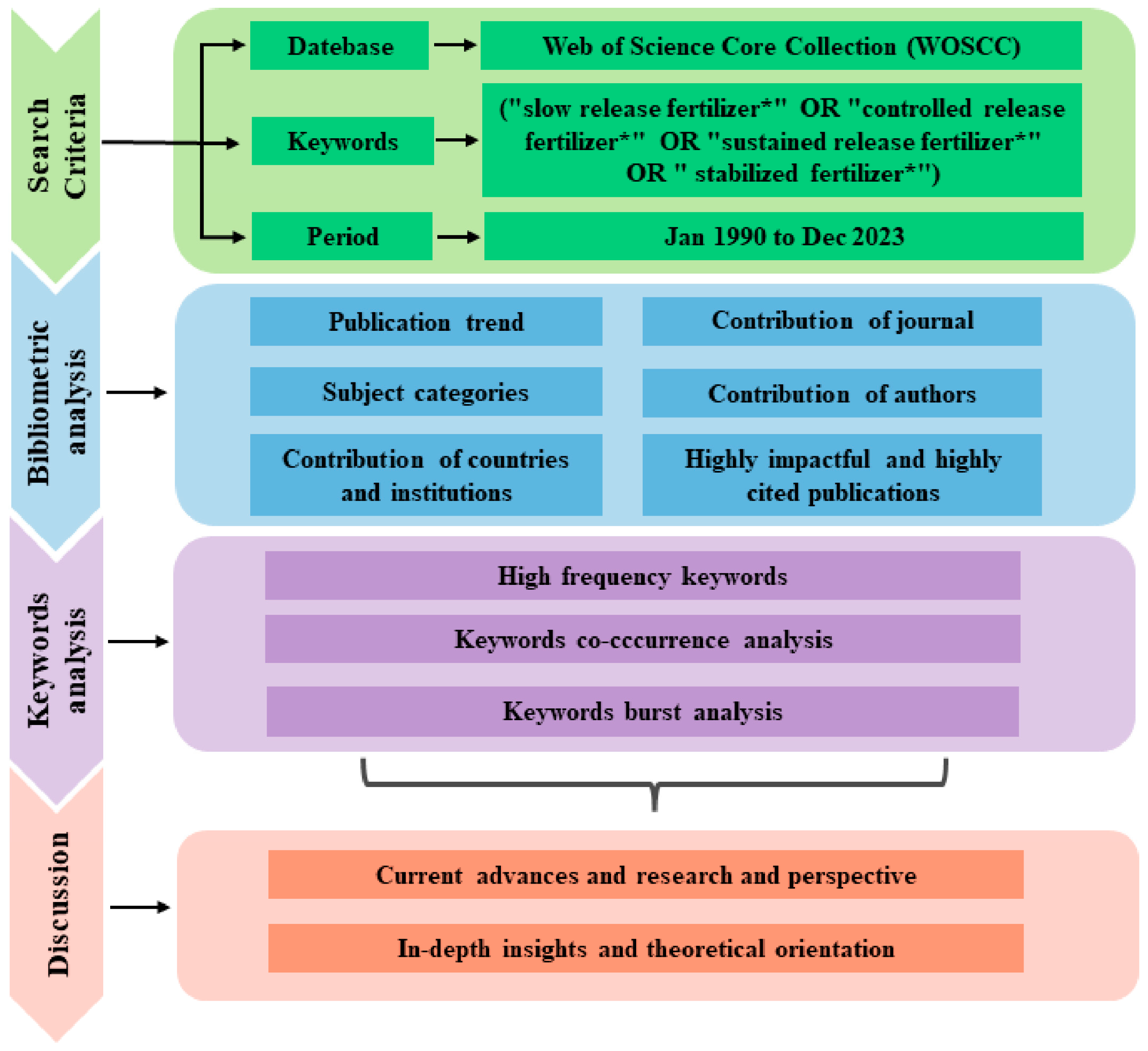
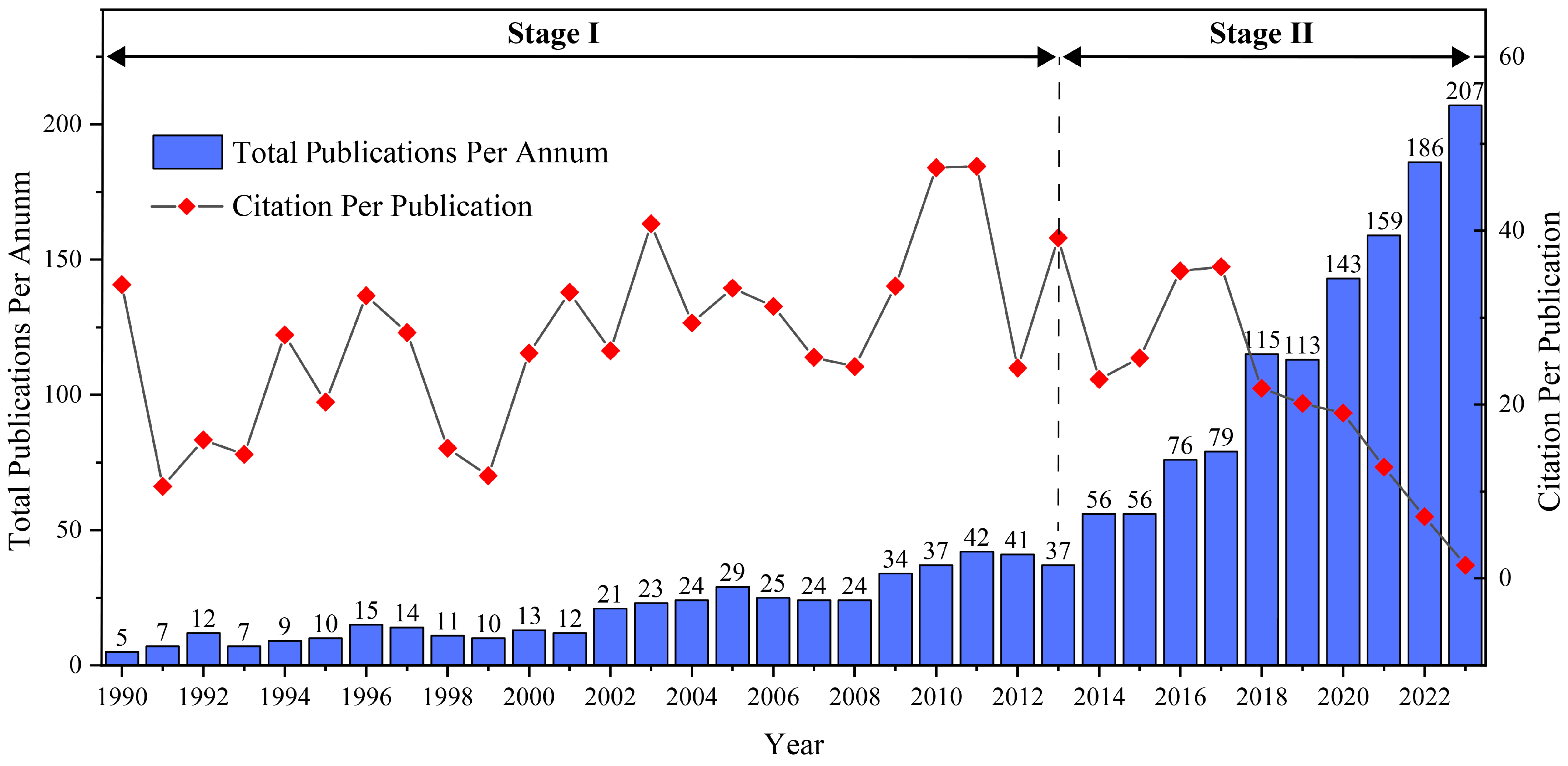

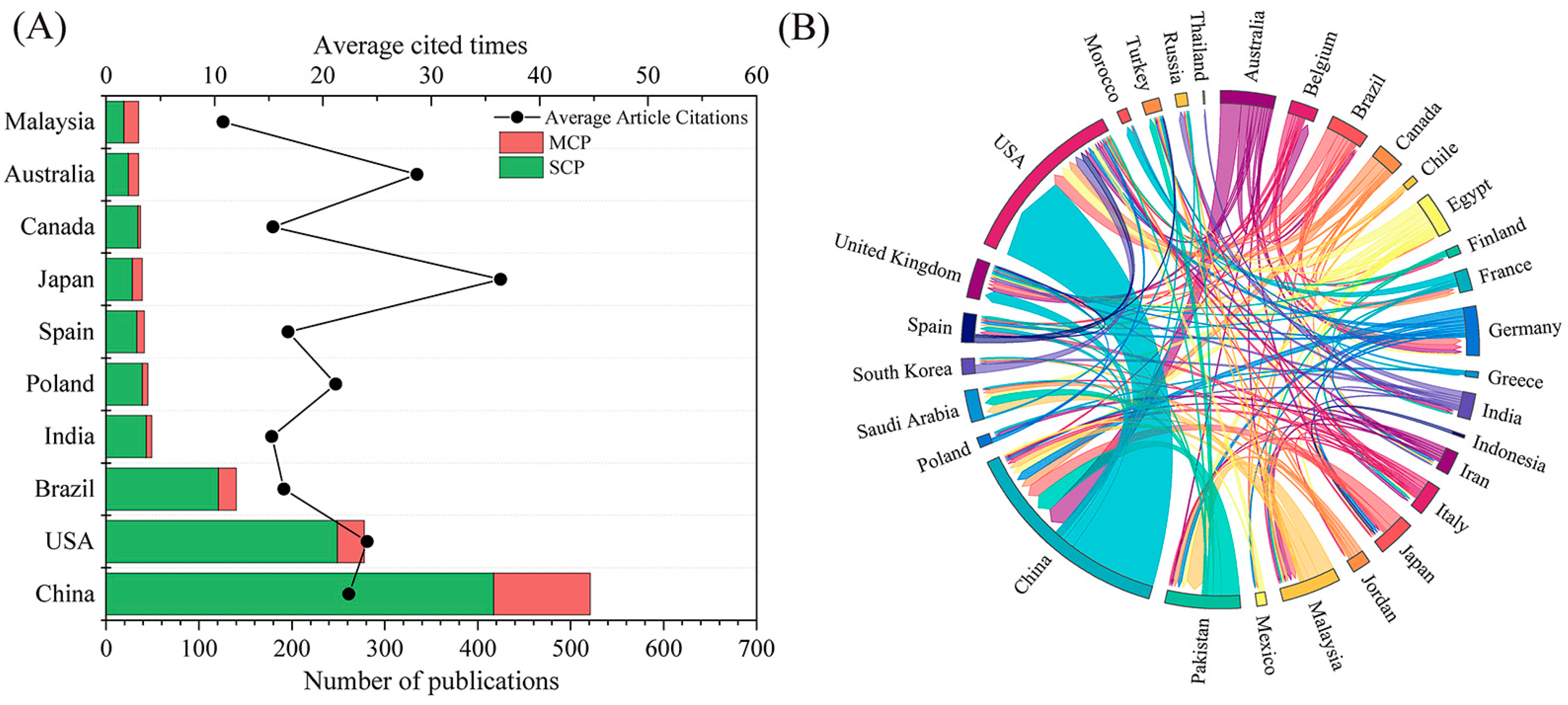
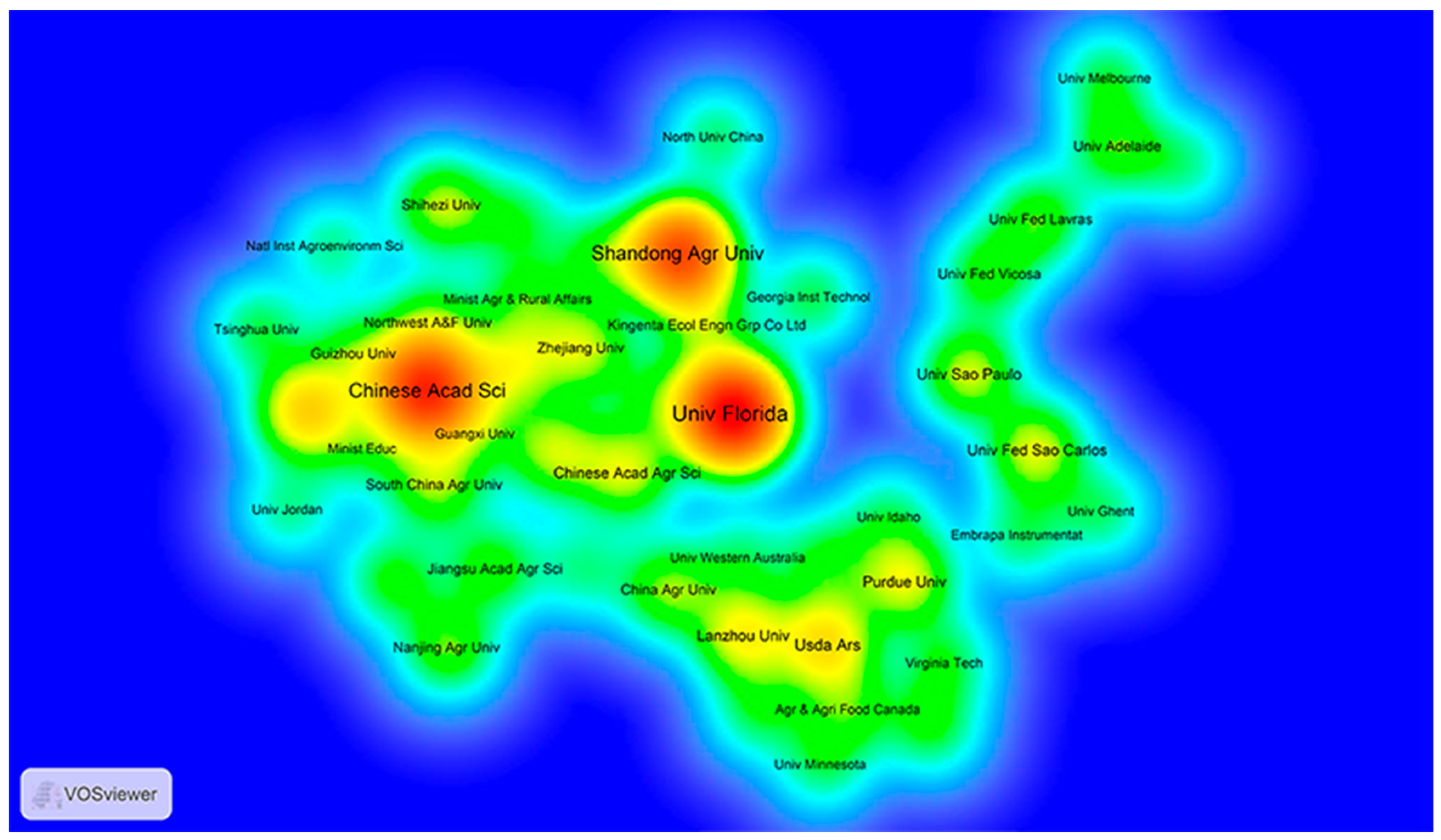
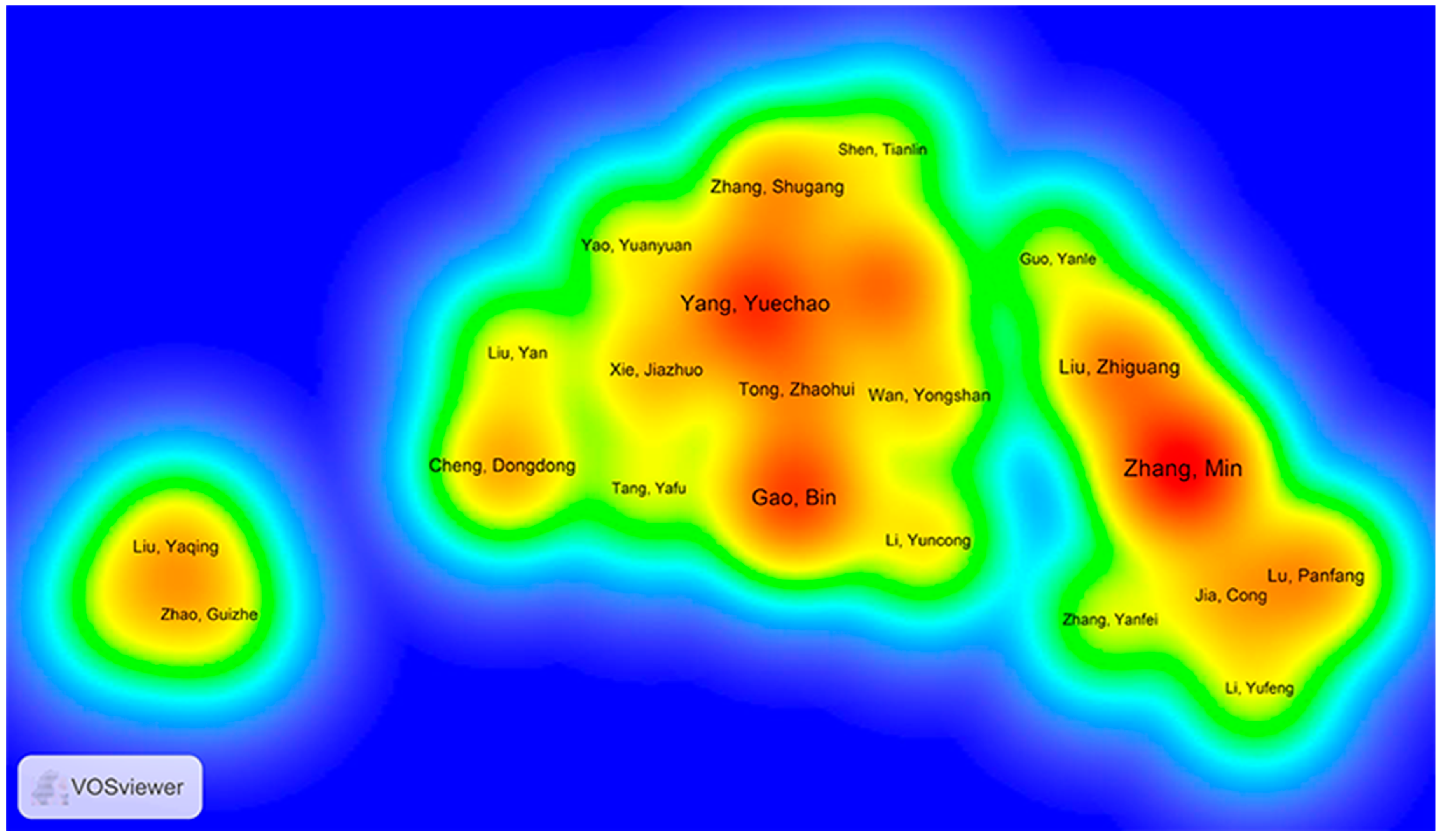
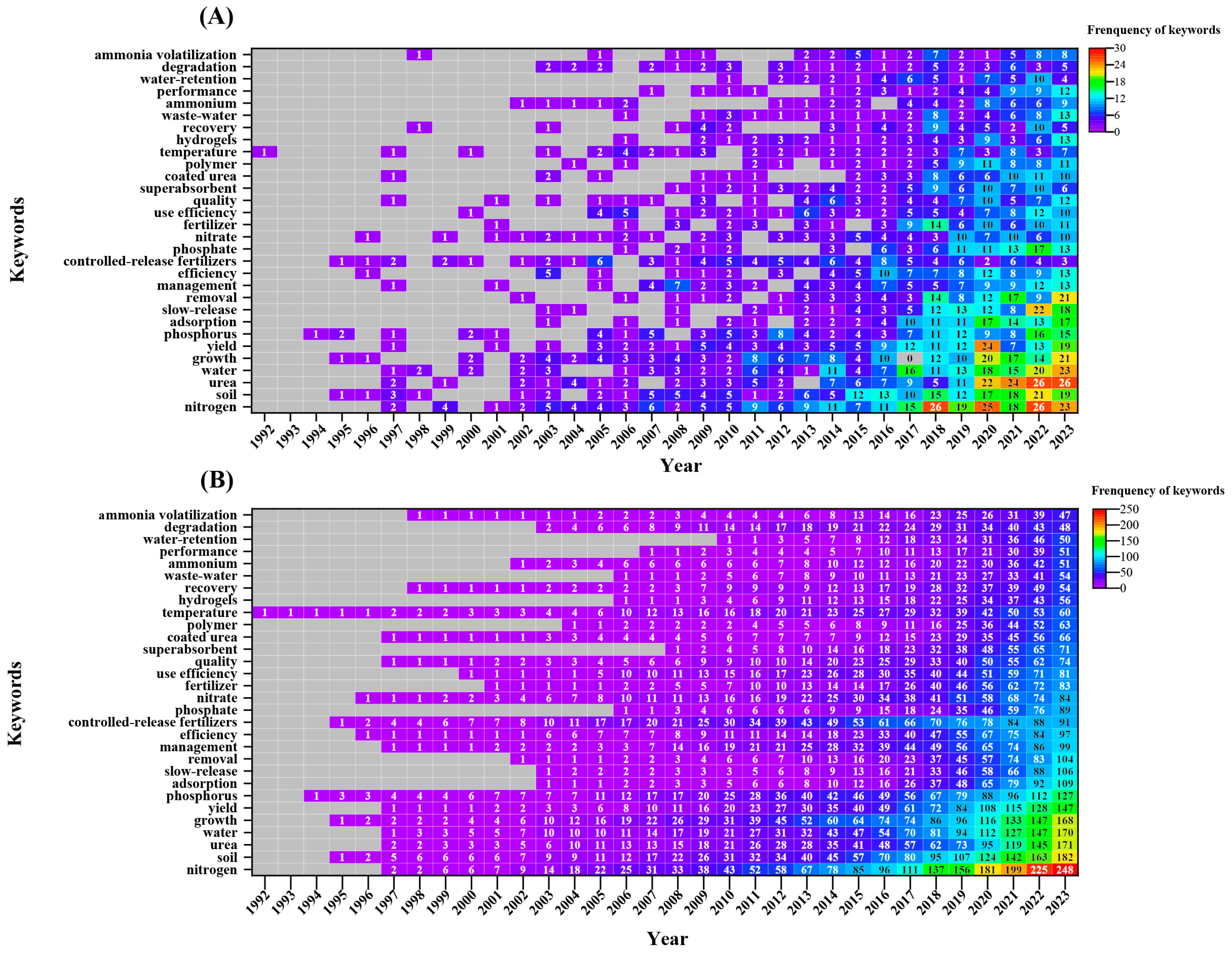

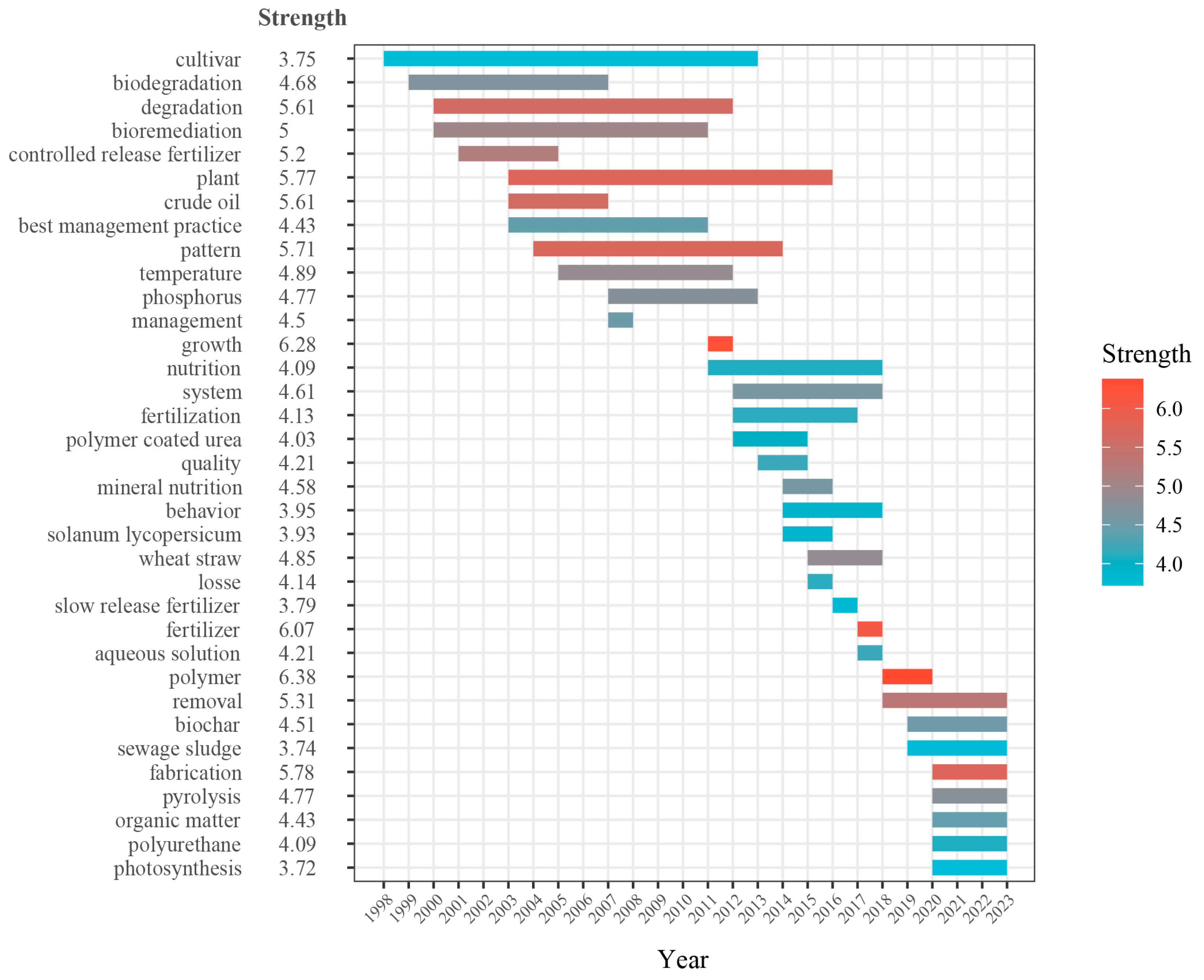
| Rank | Institution | Country and Region | Records | % of 1676 | Total Citations | Average Cited Times |
|---|---|---|---|---|---|---|
| 1 | Univ Florida | USA | 97 | 5.79 | 3217 | 33.16 |
| 2 | Chinese Acad Sci | China | 79 | 4.71 | 2534 | 32.08 |
| 3 | Shandong Agr Univ | China | 68 | 4.06 | 1613 | 23.72 |
| 4 | Univ Chinese Acad Sci | China | 29 | 1.73 | 653 | 22.52 |
| 5 | USDA Ars | USA | 26 | 1.55 | 1279 | 49.19 |
| 6 | Langzhou Univ | China | 22 | 1.31 | 1333 | 60.59 |
| 7 | Purdue Univ | USA | 20 | 1.19 | 422 | 21.10 |
| 8 | Univ Fed Sao Carlos | Brazil | 20 | 1.19 | 709 | 35.45 |
| 9 | Chinese Acad Agr Sci | China | 19 | 1.13 | 321 | 16.89 |
| 10 | Univ Sao Paulo | Brazil | 19 | 1.13 | 466 | 24.53 |
| Rank | Journal Name | Records | % of 1676 | IF2023 | Total Citations | Average Cited Times |
|---|---|---|---|---|---|---|
| 1 | Hortscience | 69 | 4.12 | 1.9 | 815 | 11.81 |
| 2 | Science of the Total Environment | 44 | 2.63 | 9.8 | 1243 | 28.25 |
| 3 | Communications in Soil Science and Plant Analysis | 37 | 2.21 | 1.8 | 672 | 18.16 |
| 4 | Journal of Agricultural and Food Chemistry | 37 | 2.21 | 6.1 | 1835 | 49.59 |
| 5 | Journal of Plant Nutrition | 37 | 2.21 | 2.1 | 480 | 12.97 |
| 6 | Horttechnology | 32 | 1.91 | 1.0 | 412 | 12.88 |
| 7 | Journal of Cleaner Production | 32 | 1.91 | 11.1 | 926 | 28.94 |
| 8 | Agronomy—Basel | 30 | 1.79 | 3.7 | 187 | 6.23 |
| 9 | International Journal of Biological Macromolecules | 28 | 1.67 | 8.2 | 614 | 21.93 |
| 10 | Journal of Applied Polymer Science | 28 | 1.67 | 3.0 | 722 | 25.79 |
| Rank | Author | Records | Total Citations | Institution | Average Cited Times |
|---|---|---|---|---|---|
| 1 | Zhang M | 36 | 832 | Shandong Agr Univ | 23.11 |
| 2 | Gao B | 23 | 1845 | Univ Florida | 80.22 |
| 3 | Yang YC | 23 | 765 | Shandong Agr Univ | 33.26 |
| 4 | Zhou JM | 21 | 446 | Chinese Acad Sci | 21.24 |
| 5 | Du CW | 20 | 430 | Nanjing Institute of Soil Science, Chinese Academy of Sciences | 21.50 |
| 6 | Shen YZ | 18 | 287 | Nanjing Institute of Soil Science, Chinese Academy of Sciences | 15.94 |
| 7 | Jacobs DF | 17 | 468 | Purdue Univ | 27.53 |
| 8 | Liu MZ | 16 | 1110 | Lanzhou Univ | 69.38 |
| 9 | Liu ZG | 16 | 391 | Shandong Agr Univ | 24.44 |
| 10 | Li YC | 15 | 730 | Shandong Agr Univ | 48.67 |
| Title | First Author | Year | Journal | Total Citation | TC per Year |
|---|---|---|---|---|---|
| Evaluation of effectiveness of enhanced-efficiency fertilizers as mitigation options for N2O and NO emissions from agricultural soils: meta-analysis | Akiyama H | 2010 | Global Change Biology | 532 | 35.47 |
| Engineered biochar reclaiming phosphate from aqueous solutions: mechanisms and potential application as a slow-release fertilizer | Yao Y | 2013 | Environmental Science & Technology | 509 | 42.42 |
| Removal of phosphate from aqueous solution by biochar derived from anaerobically digested sugar beet tailings | Yao Y | 2011 | Journal of Hazardous Materials | 442 | 31.57 |
| Ammonia volatilization from synthetic fertilizers and its mitigation strategies: A global synthesis | Pan BB | 2016 | Agriculture Ecosystems & Environment | 346 | 38.44 |
| Preparation and characterization of slow-release fertilizer encapsulated by starch-based superabsorbent polymer | Qiao DL | 2016 | Carbohydrate Polymers | 259 | 28.78 |
| Fertilizer source and tillage effects on yield-scaled nitrous oxide emissions in a corn cropping system | Venterea RT | 2011 | Journal of Environmental Quality | 227 | 16.21 |
| Recycling of manure nutrients: use of algal biomass from dairy manure treatment as a slow release fertilizer | Mulbry W | 2005 | Bioresource Technology | 220 | 11.00 |
| Environmentally friendly slow-release nitrogen fertilizer | Ni BL | 2011 | Journal of Agricultural and Food Chemistry | 210 | 15.00 |
| Use of controlled release fertilizers and nitrification inhibitors to increase nitrogen use efficiency and to conserve air and water quality | Shoji S | 2001 | Communications in Soil Science and Plant Analysis | 206 | 8.58 |
| Controlled-release fertilizer encapsulated by starch/polyvinyl alcohol coating | Han XZ | 2009 | Desalination | 203 | 12.69 |
| Clusters | Main Keywords | Research Topic |
|---|---|---|
| Red cluster | Nitrogen, plants, growth, quality, plant growth, plant nutrition, plant quality | The impact of SRFs/CRFs on crop growth and quality |
| Blue cluster | Urea, slow release, super-absorbent, | Urea-based SRFs/CRFs |
| Yellow cluster | Phosphorus, recovery, biomass, struvite, adsorption, kinetics, mechanism, | Phosphorus fertilizer slow and controlled SRFs/CRFs |
| Green cluster | Soil, management, use efficiency, nitrous, nitrous-oxide emissions, nitrification inhibitors, ammonia volatilization | Impact of SRFs/CRFs on N use efficiency, nitrification and denitrification functions in soil–plant systems |
| Purple cluster | Biogradation, bioremediation, bioavailability | Degradation aspects of SRFs/CRFs |
Disclaimer/Publisher’s Note: The statements, opinions and data contained in all publications are solely those of the individual author(s) and contributor(s) and not of MDPI and/or the editor(s). MDPI and/or the editor(s) disclaim responsibility for any injury to people or property resulting from any ideas, methods, instructions or products referred to in the content. |
© 2024 by the authors. Licensee MDPI, Basel, Switzerland. This article is an open access article distributed under the terms and conditions of the Creative Commons Attribution (CC BY) license (https://creativecommons.org/licenses/by/4.0/).
Share and Cite
Li, X.; Li, Z. Global Trends and Current Advances in Slow/Controlled-Release Fertilizers: A Bibliometric Analysis from 1990 to 2023. Agriculture 2024, 14, 1502. https://doi.org/10.3390/agriculture14091502
Li X, Li Z. Global Trends and Current Advances in Slow/Controlled-Release Fertilizers: A Bibliometric Analysis from 1990 to 2023. Agriculture. 2024; 14(9):1502. https://doi.org/10.3390/agriculture14091502
Chicago/Turabian StyleLi, Xianhong, and Zhonghong Li. 2024. "Global Trends and Current Advances in Slow/Controlled-Release Fertilizers: A Bibliometric Analysis from 1990 to 2023" Agriculture 14, no. 9: 1502. https://doi.org/10.3390/agriculture14091502






